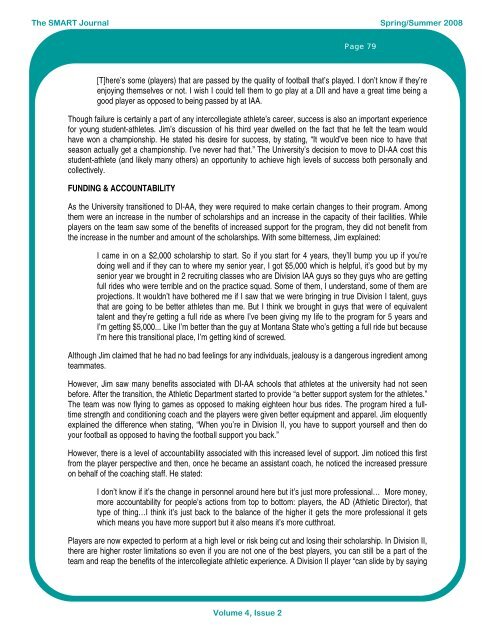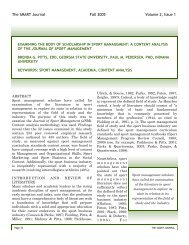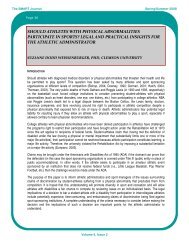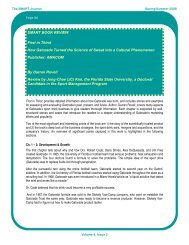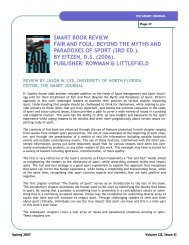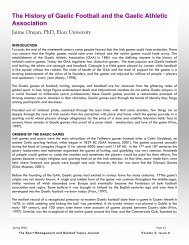Spring/Summer 2008 Volume 4, Issue 2 - The SMART Journal
Spring/Summer 2008 Volume 4, Issue 2 - The SMART Journal
Spring/Summer 2008 Volume 4, Issue 2 - The SMART Journal
Create successful ePaper yourself
Turn your PDF publications into a flip-book with our unique Google optimized e-Paper software.
<strong>The</strong> <strong>SMART</strong> <strong>Journal</strong> <strong>Spring</strong>/<strong>Summer</strong> <strong>2008</strong><br />
Page 79<br />
[T]here’s some (players) that are passed by the quality of football that’s played. I don’t know if they’re<br />
enjoying themselves or not. I wish I could tell them to go play at a DII and have a great time being a<br />
good player as opposed to being passed by at IAA.<br />
Though failure is certainly a part of any intercollegiate athlete’s career, success is also an important experience<br />
for young student-athletes. Jim’s discussion of his third year dwelled on the fact that he felt the team would<br />
have won a championship. He stated his desire for success, by stating, “It would’ve been nice to have that<br />
season actually get a championship. I’ve never had that.” <strong>The</strong> University’s decision to move to DI-AA cost this<br />
student-athlete (and likely many others) an opportunity to achieve high levels of success both personally and<br />
collectively.<br />
FUNDING & ACCOUNTABILITY<br />
As the University transitioned to DI-AA, they were required to make certain changes to their program. Among<br />
them were an increase in the number of scholarships and an increase in the capacity of their facilities. While<br />
players on the team saw some of the benefits of increased support for the program, they did not benefit from<br />
the increase in the number and amount of the scholarships. With some bitterness, Jim explained:<br />
I came in on a $2,000 scholarship to start. So if you start for 4 years, they’ll bump you up if you’re<br />
doing well and if they can to where my senior year, I got $5,000 which is helpful, it’s good but by my<br />
senior year we brought in 2 recruiting classes who are Division IAA guys so they guys who are getting<br />
full rides who were terrible and on the practice squad. Some of them, I understand, some of them are<br />
projections. It wouldn’t have bothered me if I saw that we were bringing in true Division I talent, guys<br />
that are going to be better athletes than me. But I think we brought in guys that were of equivalent<br />
talent and they’re getting a full ride as where I’ve been giving my life to the program for 5 years and<br />
I’m getting $5,000... Like I’m better than the guy at Montana State who’s getting a full ride but because<br />
I’m here this transitional place, I’m getting kind of screwed.<br />
Although Jim claimed that he had no bad feelings for any individuals, jealousy is a dangerous ingredient among<br />
teammates.<br />
However, Jim saw many benefits associated with DI-AA schools that athletes at the university had not seen<br />
before. After the transition, the Athletic Department started to provide “a better support system for the athletes.”<br />
<strong>The</strong> team was now flying to games as opposed to making eighteen hour bus rides. <strong>The</strong> program hired a fulltime<br />
strength and conditioning coach and the players were given better equipment and apparel. Jim eloquently<br />
explained the difference when stating, “When you’re in Division II, you have to support yourself and then do<br />
your football as opposed to having the football support you back.”<br />
However, there is a level of accountability associated with this increased level of support. Jim noticed this first<br />
from the player perspective and then, once he became an assistant coach, he noticed the increased pressure<br />
on behalf of the coaching staff. He stated:<br />
I don’t know if it’s the change in personnel around here but it’s just more professional… More money,<br />
more accountability for people’s actions from top to bottom: players, the AD (Athletic Director), that<br />
type of thing…I think it’s just back to the balance of the higher it gets the more professional it gets<br />
which means you have more support but it also means it’s more cutthroat.<br />
Players are now expected to perform at a high level or risk being cut and losing their scholarship. In Division II,<br />
there are higher roster limitations so even if you are not one of the best players, you can still be a part of the<br />
team and reap the benefits of the intercollegiate athletic experience. A Division II player “can slide by by saying<br />
<strong>Volume</strong> 4, <strong>Issue</strong> 2


